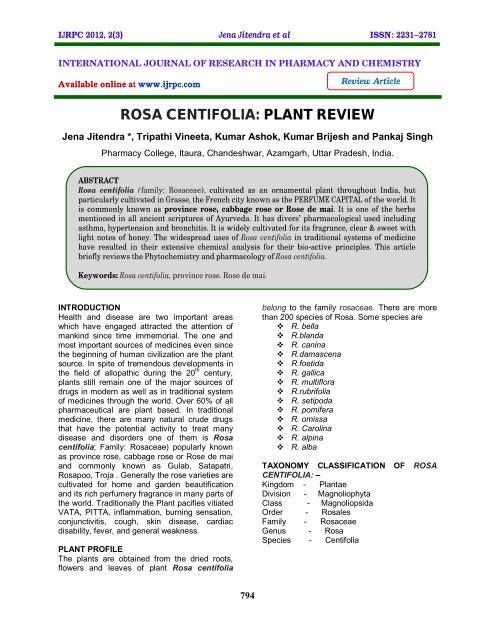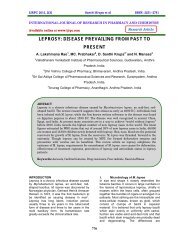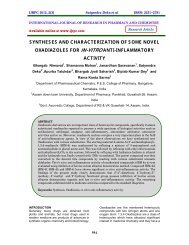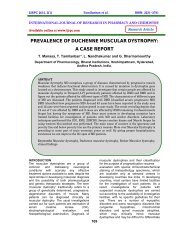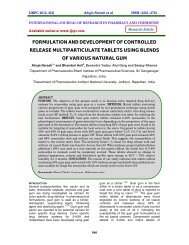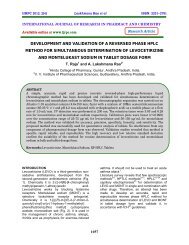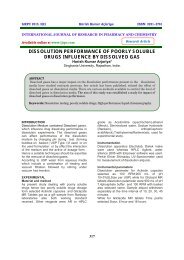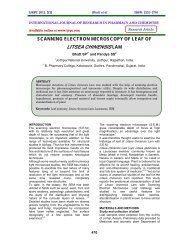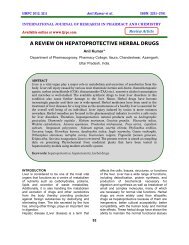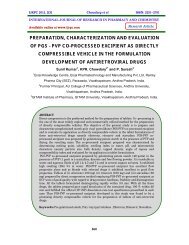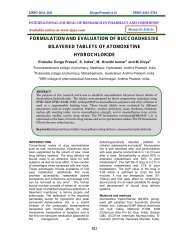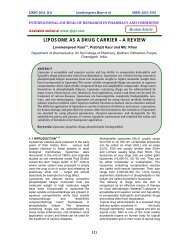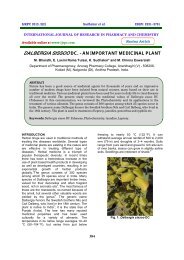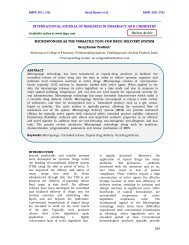ROSA CENTIFOLIA: PLANT REVIEW - ijrpc
ROSA CENTIFOLIA: PLANT REVIEW - ijrpc
ROSA CENTIFOLIA: PLANT REVIEW - ijrpc
You also want an ePaper? Increase the reach of your titles
YUMPU automatically turns print PDFs into web optimized ePapers that Google loves.
IJRPC 2012, 2(3) Jena Jitendra et al ISSN: 2231�2781<br />
INTERNATIONAL JOURNAL OF RESEARCH IN PHARMACY AND CHEMISTRY<br />
Available online at www.<strong>ijrpc</strong>.com<br />
<strong>ROSA</strong> <strong>CENTIFOLIA</strong>: <strong>PLANT</strong> <strong>REVIEW</strong><br />
Jena Jitendra *, Tripathi Vineeta, Kumar Ashok, Kumar Brijesh and Pankaj Singh<br />
Pharmacy College, Itaura, Chandeshwar, Azamgarh, Uttar Pradesh, India.<br />
INTRODUCTION<br />
Health and disease are two important areas<br />
which have engaged attracted the attention of<br />
mankind since time immemorial. The one and<br />
most important sources of medicines even since<br />
the beginning of human civilization are the plant<br />
source. In spite of tremendous developments in<br />
the field of allopathic during the 20 th century,<br />
plants still remain one of the major sources of<br />
drugs in modern as well as in traditional system<br />
of medicines through the world. Over 60% of all<br />
pharmaceutical are plant based. In traditional<br />
medicine, there are many natural crude drugs<br />
that have the potential activity to treat many<br />
disease and disorders one of them is Rosa<br />
centifolia; Family: Rosaceae) popularly known<br />
as province rose, cabbage rose or Rose de mai<br />
and commonly known as Gulab, Satapatri,<br />
Rosapoo, Troja . Generally the rose varieties are<br />
cultivated for home and garden beautification<br />
and its rich perfumery fragrance in many parts of<br />
the world. Traditionally the Plant pacifies vitiated<br />
VATA, PITTA, inflammation, burning sensation,<br />
conjunctivitis, cough, skin disease, cardiac<br />
disability, fever, and general weakness.<br />
<strong>PLANT</strong> PROFILE<br />
The plants are obtained from the dried roots,<br />
flowers and leaves of plant Rosa centifolia<br />
794<br />
Review Article<br />
ABSTRACT<br />
Rosa centifolia (family: Rosaceae), cultivated as an ornamental plant throughout India, but<br />
particularly cultivated in Grasse, the French city known as the PERFUME CAPITAL of the world. It<br />
is commonly known as province rose, cabbage rose or Rose de mai. It is one of the herbs<br />
mentioned in all ancient scriptures of Ayurveda. It has divers’ pharmacological used including<br />
asthma, hypertension and bronchitis. It is widely cultivated for its fragrance, clear & sweet with<br />
light notes of honey. The widespread uses of Rosa centifolia in traditional systems of medicine<br />
have resulted in their extensive chemical analysis for their bio-active principles. This article<br />
briefly reviews the Phytochemistry and pharmacology of Rosa centifolia.<br />
Keywords: Rosa centifolia, province rose. Rose de mai.<br />
belong to the family rosaceae. There are more<br />
than 200 species of Rosa. Some species are<br />
� R. bella<br />
� R.blanda<br />
� R. canina<br />
� R.damascena<br />
� R.foetida<br />
� R. gallica<br />
� R. multiflora<br />
� R.rubrifolia<br />
� R. setipoda<br />
� R. pomifera<br />
� R. omissa<br />
� R. Carolina<br />
� R. alpina<br />
� R. alba<br />
TAXONOMY CLASSIFICATION OF <strong>ROSA</strong><br />
<strong>CENTIFOLIA</strong>: –<br />
Kingdom - Plantae<br />
Division - Magnoliophyta<br />
Class - Magnoliopsida<br />
Order - Rosales<br />
Family - Rosaceae<br />
Genus - Rosa<br />
Species - Centifolia
IJRPC 2012, 2(3) Jena Jitendra et al ISSN: 2231�2781<br />
CULTIVATION<br />
Rosa centifolia are particularly to the French city<br />
of Grasse known as the perfume capital of the<br />
world. It is widely cultivated for its fragrance. The<br />
flowers are commercially harvested for the<br />
production of rose oil, which is commonly used<br />
in perfumery. The plants cultivated are therefore<br />
recommended because of their higher flower<br />
production.<br />
MORPHOLOGY<br />
The plant is shrubby and grows up to 1.5-2<br />
meters in height. Leaves are grayish green in<br />
colour, compound, imperipinnate, with 5-7<br />
leaflets and the leaflets are ovate- lancelets.<br />
Flowers are varying in colour, usually pink,<br />
fragrant, with many petals. They are fleshy hip<br />
enclosing small and pendulous seeds. They are<br />
round shape, globular with their overlapping<br />
petals.<br />
CHEMICAL CONSTITUENTS<br />
The important chemical constituents isolated<br />
from flower petals by gas chromatographic<br />
analysis, were Phenyl ethanol (43%), Geranyl<br />
acetate (15.6%), Geraniol (10.5%), Linalool<br />
(6.9%), Benzyl alcohol (3.3%), Benzaldehyde<br />
(1.5%), Nerol (5-10%), Citronellyl acetate<br />
(0.3%).<br />
It also contains tannins, oloigomeric<br />
proantrocyanides, saccharine matter, mineral<br />
salts, salt of mallic acid & tartaric acid, Pectin<br />
(11%), Riboflavin, sugars, purgative glycosides<br />
(multiflorin A & B).<br />
USEFUL PART OF <strong>ROSA</strong> <strong>CENTIFOLIA</strong><br />
Generally the Leaves, Root, Flowers part are<br />
used.<br />
TRADITIONAL USE OF <strong>ROSA</strong> <strong>CENTIFOLIA</strong><br />
Traditionally the Plant pacifies vitiated VATA,<br />
PITTA, inflammation, burning sensation,<br />
conjunctivitis, cough, skin disease, cardiac<br />
disability, fever, and general weakness.<br />
Generally the several rose products are used to<br />
make different cosmetic preparation like creams,<br />
lotions and other cosmetic uses. It used for<br />
moisturizing purpose by mixing with vegetable<br />
glycerin. It was also used in toilet preparations,<br />
lozenges and toothpaste for its perfumery. Rose<br />
water is used in desserts, pastries and cakes.<br />
The flower buds are generally used in cardiac<br />
troubles and as a tonic and aperients. Gulkand<br />
made from the petals possesses mild laxative<br />
properties and is useful in sore throat and<br />
enlarged tonsils.<br />
795<br />
PHARMACOLOGICAL ASPECTS<br />
� The roots are useful in intestinal ulcers,<br />
rickets, hemorrhages and diarrhea and<br />
also astringent in nature.<br />
� The leaves are used in treating wounds,<br />
ophthalmia, hepatopathy and<br />
hemorrhoids.<br />
� The flowers has cooling emollient<br />
aromatic, cardio tonic, antiinflammatory,<br />
expectorant, aphrodisiac,<br />
depurative, febrifuge, intellect-promoting<br />
styptic, digestive, carminative,<br />
rejuvenating and tonic properties. It is<br />
also useful in asthma, high blood<br />
pressure, bronchitis, diarrhea,<br />
dysmenorrheal, cough, fever, fluid<br />
retention, insomnia, palpitation, and<br />
stress and urinary tract infections.<br />
� Tea made from petals used as- blood<br />
purifier, vertigo, and headache.<br />
� Mild sedative, local anesthetics,<br />
laxatives, liver protectors,<br />
antidepressant, cardio-active.<br />
� Rose petals are rejuvenating & prove to<br />
be a tonic.<br />
� Due to small and pleasant fragrance<br />
rose petals are used for making<br />
essential oils and perfumes.<br />
� Used as antioxidant, & antitussive.<br />
� It inhibits vasoconstriction.<br />
� It shows potent antibacterial activity.<br />
� It inhibits the growth of leukemia cell<br />
line<br />
� Ointment of rose-water<br />
It is commonly known as Cold Cream, enjoys<br />
deserved popularity as a soothing, cooling<br />
application for chapping of the hands, face,<br />
abrasions and other superficial lesions of the<br />
skin.<br />
BIOLOGICAL AND PHARMACOLOGICAL<br />
ACTIVITIES<br />
Antibacterial activity<br />
Hassan Ali et al, 2003 showed that Rosa<br />
centifolia water extract possesses significant<br />
antibacterial activity. It showed anti-microbial<br />
activity against bacterial strains like M.<br />
lysoditicus, S.aureus, C. pseudodiptheroid, S.<br />
dysenters, S. typhi, E. coli and S. pyogenes.<br />
Anti tussive activity<br />
Sankar et al,2011showed that the ethanol<br />
extract of Rosa centifolia produced significant<br />
anti-tussive activity. The essential oil obtained<br />
from Rosa centifolia is reported gastro
IJRPC 2012, 2(3) Jena Jitendra et al ISSN: 2231�2781<br />
intestinal relaxant activity; therefore the<br />
bronchodilatory effect is responsible for its antitussive<br />
property and might be due to its possible<br />
tachykinin inhibitory substance mediating antitussive<br />
effect.<br />
CONCLUSION<br />
Rosa centifolia have been ethno medicinally<br />
used as a therapeutic agent for a variety of<br />
diseases, as we have illustrated in this article.<br />
More ever, numerous research works have<br />
proven its uses beyond the ethno medicinal<br />
ones in experimental animals. Citronella &<br />
farnesol which were isolated from this plant may<br />
be responsible for these actions. Researchers<br />
are of the opinion that the presence of mallic<br />
acid and citric acid are the reason behind the<br />
laxative and diuretic effect.<br />
Leaves<br />
Flowers<br />
796<br />
Roots<br />
REFERENCES<br />
1. Hassan Ali; Nafisa; An investigation of<br />
antimicrobial compounds for<br />
immunomodulating and anti-adhesion<br />
properties, Pakistan Research<br />
Repository; 2003.<br />
2. K. Anu Kiruthika et al /Int.J. PharmTech<br />
Res.2011,3(2).<br />
3. M. Canales et al. / Journal of Ethno<br />
pharmacology 97 (2005) 429–439.<br />
4. M. KHALID SHABBIR ET AL., Pak. J.<br />
Bot., 41(2): 615-620, 2009.<br />
5. Nadkarni K. M.; Indian Material Medica,<br />
vol-1, page no-1071.<br />
6. Rastogi Ram P; Mehrotra B. N.;<br />
Compendium of Indian medicinal plant,<br />
volume-3rd (1980-1984) Page no:-554.<br />
7. Sankaranand R; Evaluation of antitussive<br />
activity of Rosa centifolia,<br />
IJPSR, 2011; Vol. 2(6). 1473-1475.<br />
8. The Wealth of India, vol-IX, page no-<br />
66-67.


